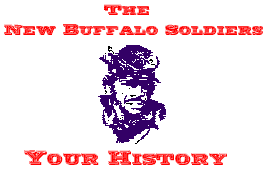

As we learned in Volume No. 1, Co.
A was sent West in February 1867, with Cos. B and C following
over the next several months. They were dispatched to Fort Gibson,
Indian Territory. In August, Grierson was transferred to Fort
Riley, Kansas, where the remaining 4 companies were formed. From Fort Riley, the regimental headquarters
until April, 1868, the 10th spread out over Indian Country, (Kansas,
Oklahoma and parts of Texas). They were sent to Fts Wallace, Larned,
Hays, Gibson and Arbuckle. The Tenth quickly got into action and
began to take casualties. In August of 1867, Co. F saw action
in which a sergeant was shot through the head when as he and 34
other troopers were attacked by 50-70 Cheyenne. Later in the month
at Beaver Creek they lost another trooper.
In September, another group of troopers was attacked while guarding
a railroad camp. In May of 1868, the regimental headquarters was
moved to Fort Gibson. 1868, saw some important actions. These
included 2 in October, Early in the month Colonel Carpenter and
H Troop covered 100 miles in a day to ride to the rescue of Colonel
Forsyth and his 50 scouts that were trapped for about a week on
a small island on the Aricharee fork of the Republican River,
by several thousand Indians under Chief Roman Nose. A short time
later, Carpenter with Cos. H and I came under attack while escorting
Carr of the 5th Cav.
The actions at Beecher Island and Beaver Creek resulted in a promotion
and Congressional Medal of Honor for Carpenter and praise from
Major-General Sheridan in a General Order on 10/27/68 for the
bravery and gallantry of the troop. During the Winter Campaign
the 10th played key roles including guarding Indians and securing
escape routes for the Cheyenne, which were attacked on the Washita
by Custer. Cos. B, F, G and K worked out of Fort Lyon with a troop
of the 7th Cav under Penrose. With Wild Bill Hickock as scout
they abruptly ran into a severe blizzard a few days out. In the
first week they lost 39 horses and being equipped with 45 days
ration starvation was a serious problem. Finally they were "rescued"
by Carr and the 5th Cav.
The remainder of the 1869 was spent babysitting Kiowas, Comanche,
Southern Cheyenne and Arapahoe, building bridges, constructing
Fort Sill and working out of Camp Washita, Camp Supply and Fort
Sill.
References
1. The Buffalo Soldiers: A Narrative of the Negro Cavalry in the
West; William Leckie. University of Oklahoma Press 1967.
2. Indian Fight and Fighters; Cyrus Townsend Brady, University
of Nebraska Press 1971.[Beaver Creek and Beecher Island].
© 2000-2001 by Dr John Productions
The New Buffalo Soldiers
Shadow Hills, CA.
All rights reserved.